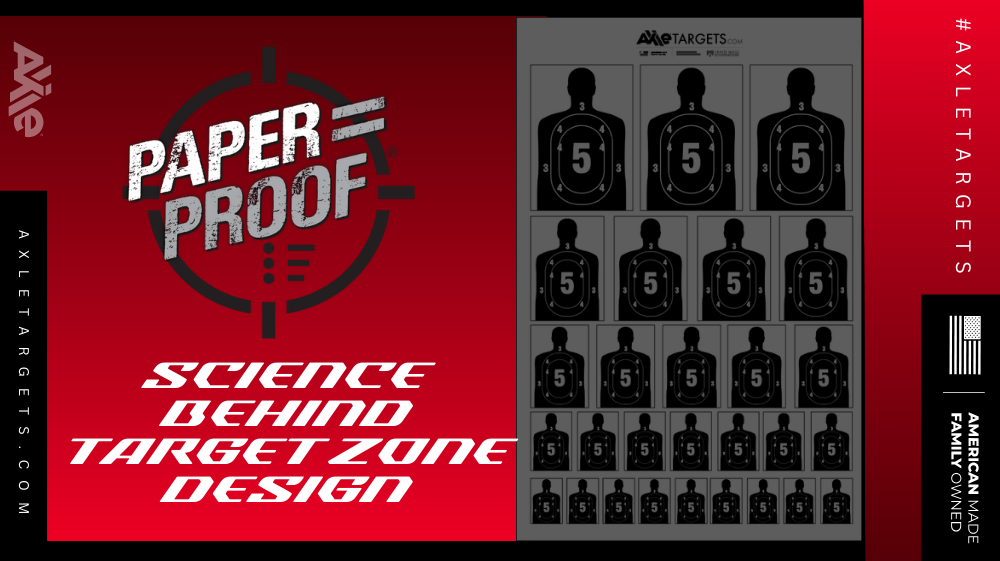Introduction: Why Target Zones Matter
When most shooters head to the range, they see paper targets as simple tools—a sheet of paper with circles or silhouettes meant to catch rounds. But behind every effective target zone design is a foundation of ballistics, human anatomy, and performance psychology. Paper shooting targets are carefully engineered to measure accuracy, sharpen reaction time, and simulate real-world scenarios.
In this article, we’ll break down the science of target zone design, show you how specific layouts help improve marksmanship, and spotlight some of Axle Targets’ most effective paper targets. Whether you’re training for concealed carry, law enforcement qualification, or simply pushing your skills further, understanding target zones can make the difference between casual shooting and precision-driven improvement.
The Psychology of Target Zones
Targets aren’t designed randomly. The layout of scoring rings, silhouettes, and high-value zones all serve a purpose:
-
Focus and Precision – Smaller target zones force the shooter to concentrate, fine-tuning sight alignment and trigger control.
-
Stress Simulation – Multiple zones simulate decision-making under pressure, mimicking real-world defense or tactical situations.
-
Reinforcement of Good Habits – Scoring rings reward consistency and discourage sloppy trigger pulls or poor stance.
For example, bullseye-style targets condition shooters to aim small, miss small, while silhouette targets prepare shooters for defensive accuracy where shot placement matters most.
Anatomy Meets Accuracy: Human-Centered Target Design
Many popular shooting targets are based on human anatomy—chest and head areas—because these are the zones that law enforcement, military, and defensive shooters must train to neutralize threats effectively.
-
Vital Zone Placement – Heart, lungs, and cranial zones are positioned to represent realistic defensive engagements.
-
Scaled Distances – Targets are often proportioned to simulate a human figure at 5, 10, or 25 yards.
-
Immediate Feedback – Shooters instantly see if they’re delivering effective hits where it matters most.
This is why designs like the B27 Target remain a gold standard across agencies and civilian training programs alike.
Geometry and Ballistics: The Math Behind Targets
Targets aren’t just about human silhouettes—geometry plays a huge role in skill development:
-
Circular scoring zones train sight alignment and grouping.
-
Cluster patterns force shooters to transition quickly and adapt sight picture.
-
Reduction targets simulate distance shooting in confined spaces.
The B8 Cluster Target, for instance, uses multiple scoring bullseyes across a single sheet. This lets shooters practice transitions, rhythm drills, and shot placement without resetting targets constantly. It’s an efficient, science-backed training tool for both beginners and experts.
Product Spotlights: Axle Targets That Define Precision
🎯 2" Drill TargetThe 2" Drill Target is engineered for pinpoint accuracy. With ultra-small scoring circles, this target forces you to refine your sight picture and trigger pull. Perfect for advanced shooters or those running “aim small, miss small” drills, it’s one of the best tools to sharpen fine motor accuracy under pressure. |
 |
 |
🎯 B8 Cluster TargetThe B8 Cluster packs multiple bullseyes into one sheet, making it ideal for transition training and shot grouping practice. Rather than constantly swapping targets, you can run multiple strings of fire and measure consistency across each bullseye. Its high-density training format makes it a favorite for competitive shooters and tactical courses. |
🎯 B27 TargetThe legendary B27 silhouette target has been used by law enforcement and military for decades. Designed with vital-zone scoring rings, it helps shooters build defensive accuracy that translates directly to real-world scenarios. Whether you’re training for personal defense or qualification standards, the B27 ensures you’re hitting where it counts. |
 |
 |
🎯 K Reduction TargetThis target uses scaled scoring zones to simulate long-distance engagements at closer range. It’s a smart design for shooters who don’t have access to extended ranges but still want to practice precision. By reducing the size of the scoring rings, the K Reduction sharpens accuracy under tighter margins. |
🎯 Anatomy Target (Optional Alternate Choice)The Anatomy Target brings together realism and science, mapping out vital hit zones for training that emphasizes threat neutralization accuracy. It’s ideal for self-defense practice and helps shooters see exactly how placement translates to effectiveness. |
 |
Expert Tips: Maximizing Target Zone Training
-
Train Transitions – Use multi-zone targets like the B8 Cluster to practice moving your sights quickly and accurately.
-
Start Small, Scale Up – Begin with a 2" Drill Target to refine accuracy, then move to silhouettes to add speed and decision-making.
-
Incorporate Stress – Time your drills or add movement to replicate defensive shooting pressure.
-
Track Progress – Save your paper targets after each range trip. Comparing past sessions gives you measurable evidence of improvement.
-
Mix Target Types – Rotate between bullseyes, clusters, and silhouettes for a balanced training regimen.
Conclusion: Sharpen Skills with the Right Targets
Target zones aren’t just shapes on paper—they’re the result of science, geometry, and psychology working together to improve your shooting skills. Whether you’re drilling precision shots on the 2" Drill Target, running transitions on the B8 Cluster Target, or simulating defensive accuracy with the B27 Target, Axle Targets provides the paper designs you need to train smarter.
The next time you step into a shooting range, remember this: the target you choose defines the shooter you become.
👉 Explore the full range of paper shooting targets at AxleTargets.com and upgrade your training today.

